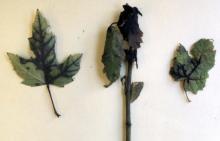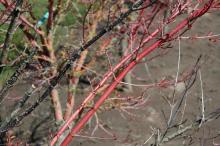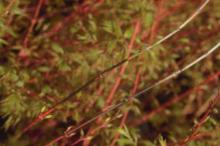Cause Pseudomonas syringae pv. syringae, the same bacterium that causes bacterial blight of lilac, fruit trees, and many woody ornamentals. It overwinters on infected plant parts or as an epiphyte on healthy tissue. It spreads with windblown rain, insects, and pruning tools. Bacteria enter through wounds or natural openings. Wound infection during budding may interfere with bud-take. Frost damage, high nitrogen fertilization (especially late summer), and heavy rains favor bacterial invasion. Most species, especially Acer rubrum, are susceptible except sugar maples. Most Japanese maple cultivars such as Sango Kaku and Oshi Beni are highly susceptible. Trees with Verticillium wilt may be more susceptible to symptom development.
Although the bacteria survive on the outside of the plant they must get inside and multiply in the space between plant cells (apoplast) to cause disease. These pathogenic bacteria inject several proteins and small-molecule toxins to get past host immune mechanisms. Once inside, the bacteria induce a watery, nutrient rich environment between the plant cells where they can multiply and continue colonization of the plant tissues. Bacteria also produce a protein that acts as an ice nucleus, increasing frost wounds that bacteria easily colonize and expand.
Symptoms Symptoms include leaf spots, vein blackening, and tip dieback of Japanese, Norway, and red maples. Leaf spots vary from pinpoint size to 0.25 inch in diameter. Most leaf spots begin as a water-soaked area and may show a chlorotic halo. Spots may coalesce, destroying leaves or young seedlings.
Year-old twigs may turn black during the dormant season. These twigs then turn ash-gray with a black band of tissue near the advancing lesion. Buds can turn black and fail to break in spring, or shoots may leaf out and then die back. Twigs may continue to die back through spring as blackened tissue continues to expand toward the shoot's base.
Cultural control
- Plant resistant cultivars or avoid highly susceptible cultivars.
- Carefully handle young plants.
- If possible, do all pruning and budding, or any practice that wounds plants, in dry weather.
- Protect from rain and frost, if feasible, in early spring or late fall. Plastic shelters have been as good as or better than chemical methods against the same disease on other crops.
- Remove and destroy dead and/or blackened twigs and fallen leaves.
- Maintain adequate spacing for good air circulation.
- Avoid high-nitrogen fertilization that produces a lot of late-season growth, which causes plants to be more sensitive to winter injury and thus more susceptible to bacteria.
Chemical control Must use with cultural controls. Many bacteria resistant to copper-containing products and to antibiotics have been detected in Pacific Northwest nurseries.
- Fixed coppers. Apply in fall to protect wounds and leaf scars, in spring to protect new growth. Spring sprays must be applied under fast-drying conditions to avoid leaf injury. O
- Badge X2 at 1.5 to 2 lb/A. Group M1 fungicide. 24-hr greenhouse, 48-hr field reentry. O
- CuPRO 5000 at 1.5 to 5 lb/A but only up to 2 lb/A when new growth is present. Group M1 fungicide. 48-hr reentry.
- Junction at 1.5 to 3.5 lb/A. Group M1 + M3 fungicide. 48-hr reentry.
- Phyton 27 at 1.5 to 2.5 oz/10 gal water. Group M1 fungicide. 48-hr reentry.
Reference Malvick, D.L. and Moore, L.W. 1988. Survival and dispersal of a marked strain of Pseudomonas syringae in a maple nursery. Plant Pathology 37:573-580.
Parajuli, M., Oksel, C., Avin, F. A., Liyanapathiranage, P. and Baysal-Gurel, F. 2023. First Report of Bacterial Leaf Spot of Red Maple Caused by Pseudomonas syringae pv. syringae in Tennessee. Plant Disease, 107:2515-2516.






